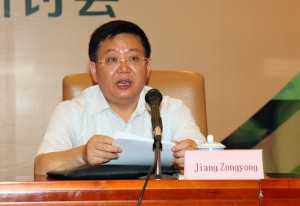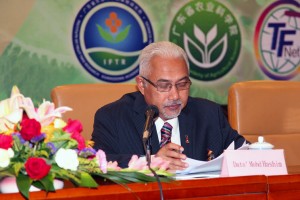The 5th International Symposium on Tropical and Subtropical Fruits (ISTSF) was held in Guangzhou, China on 18-20 June 2012. It was jointly organized by Institute of Fruit Tree Research, Guangdong Academy of Agricultural Sciences (IFTR-GDAAS); International Tropical Fruits Network (TFNet); International Society for Horticultural Sciences (ISHS); Hunan Agricultural University; and Guangdong Fruit Association.
A total of 230 participants from 23 countries attended the symposium, including those from Australia, Bangladesh, Brazil, China, Fiji, Italy, Malaysia, Sudan, Thailand and USA. Participants hail from renowned academic and research institutions, international organizations, government agencies and the private sector.
A total of 65 oral presentations were delivered on two concurrent sessions. Meanwhile, 57 posters were displayed in the exhibition area. The oral and poster presentations were classified into 6 major topics, which are germplasm, diversity and breeding; molecular biology and biotechnology; production technology and physiology; postharvest and processing technology; pest and disease management; and economics, marketing, and trade.
“The industry of tropical and subtropical fruits has becoming one of the most important pillar industries in producing regions, having a huge market around the world,” said GDAAS President Jiang Zongyong during his opening remarks. He added that as diseases and climate change threaten the industry, the symposium provided an avenue for stakeholders to exchange valuable information.
“The potential for development of tropical and subtropical fruits depends on continuous improvement on technology for production and postharvest management,” said ISHS Section on Tropical and Subtropical Fruits Chair Sisir Kumar Mitra. He added that “Global partnerships are imperative to integrate scientific and technological innovation”.
Other special guests in the opening ceremony included Malaysian Secretary General for Agriculture HE Dato’ Mohd Hashim Abdullah, Liu Yan from the Chinese Ministry of Agriculture, Hunan Agriculture President Zhou Qingming, Cheng Ping from the Guangdong Department of Agriculture Zhong Xiaoping from the Guangdong Department of Science and Technology, and TFNet CEO Yacob Ahmad. GDAAS Vice President and Convener Yi Ganjun chaired the ceremony.
FAO Senior Economist Kaison Chang chaired the first session that featured keynote papers such as “Challenges and Issues in Developing the Tropical and Subtropical Fruit Industry in China” by Deng Xiuxin , President of Huangzhong Agricultural University, China; “A Systems Approach to Improve Research Outcomes in Tropical Fruit Production and Supply Chains” by Bob Williams, Director of the Australian Department of Plant Industries; “Current Status of Huanglongbing (HLB) in China and Future Control Strategies” by Zhong Guangyan of IFTR-GDAAS; and “Crop Regulation for Tropical Fruit Production” by Sisir Kumar Mitra, Chair of the ISHS Section on Tropical and Subtropical Fruits.
The symposium highlighted recent research and development in production and postharvest fruit technologies; discussed current issues on consumer demand, market access, and trade; provided a forum for information exchange among researchers, producers, academicians, traders, policy makers, and other stakeholders in the tropical and subtropical fruit industry; and established and strengthened network linkages between the researchers, producers, traders, policy makers and other stakeholders in the tropical and subtropical fruit industry.
In the exhibition booth, TFNet Associate Member Sime Darby Plantation displayed GOFRESH – a line of pink guava juice products. ISHS and TFNet also displayed their materials.
To celebrate the symposium, a gala banquet was organized on June 19. Participants enjoyed the food and were entertained by a Chinese cultural show.
After the sessions, the participants went on a field trip to a commercial organic banana farm managed by the Zengcheng Xianghui Banana Farmers’ Cooperative, the Jiangnan wholesale fruit market, the Baiyun National Agricultural Science and Technology Park of Guangzhou, and the South China Agricultural Research and Innovation Center.



